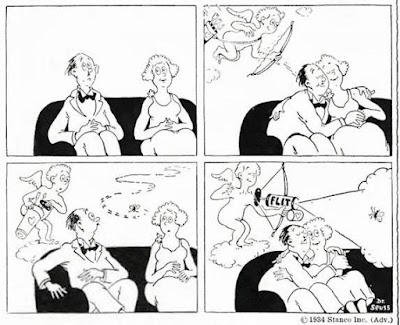Dr Seuss has been much beloved for his children’s book since I was a child, many years ago. In the 1950s, when I was that child, a Dr Seuss book would be a welcome gift at Christmas, and if I found one at the library it was a special treat. The Cat in the Hat early readers came later. While I was aware of them, I had moved on to other things. Still, when it came time for my son to learn to read, he had those books to help him.
Early on in his career Theodore Seuss Geisel was an advertising artist. One of his main clients was Standard Oil, under the name Stanco, that manufactured and sold the mosquito spray, Flit. Dr Seuss had the account for 17 years, and the slogan “Quick, Henry, the Flit!” became a catchphrase of the era. My father, who grew up in the Great Depression, filled me in on the pop culture and life in the thirties and forties from the time I was old enough to listen, and “Quick, Henry, the Flit!” was part of that informal education.
These examples of one-panel Flit ads were drawn by Dr Seuss, and published in issues of The New Yorker from the years 1933-36.
Wednesday, September 19, 2018
Thursday, September 13, 2018
Cartoonist George Price and the levitating men
George Price worked for the New Yorker magazine for 62 years. His first drawings appeared in 1929. He was invited to join the magazine’s staff, but he would only do it if someone else wrote the gags. That information came from the 2006 book, Complete Cartoons of the New Yorker. I don’t know who did those gags, or if a lot of different writers and/or other cartoonists joined in and submitted gags. It must have worked, because Price came up with about 1200 published cartoons over his (and his gag writer(s)) long careers.
I found this series of jokes about a levitating man in 1934 and 1935 issues of The New Yorker. Together they form a continuity, so I have arranged them chronologically.
All drawings are Copyright © The New Yorker
Price had a way with floaters. These two cartoons are not part of the continuity, but have levitation. The 1934 anti-gravity joke was published before the levitating man jokes, and the Indian rope trick gag was done after, in 1936.
Here is a gag picture of Price as his own levitating man. Date unknown.
I found this series of jokes about a levitating man in 1934 and 1935 issues of The New Yorker. Together they form a continuity, so I have arranged them chronologically.
All drawings are Copyright © The New Yorker
Price had a way with floaters. These two cartoons are not part of the continuity, but have levitation. The 1934 anti-gravity joke was published before the levitating man jokes, and the Indian rope trick gag was done after, in 1936.
Here is a gag picture of Price as his own levitating man. Date unknown.
Monday, July 23, 2018
Charles Addams: Wide-eyed and surprised
Cartoonists like to pull a switch, present a situation where the reader's expectations are met with something off-the-wall or different enough to evoke a laugh. Charles Addams was a master of the switch, or what can be called wide-eyed and surprised, when the onlookers in the cartoon see something startling.
These 19 drawings are taken from the online New Yorker archive, and were originally published in the early 1950s. All are shown here as examples.
Go back to the previous posting to see more Addams.
These 19 drawings are taken from the online New Yorker archive, and were originally published in the early 1950s. All are shown here as examples.
Go back to the previous posting to see more Addams.
Subscribe to:
Comments (Atom)






























































